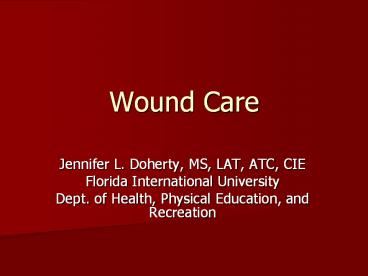Wound Care PowerPoint PPT Presentation
1 / 30
Title: Wound Care
1
Wound Care
- Jennifer L. Doherty, MS, LAT, ATC, CIE
- Florida International University
- Dept. of Health, Physical Education, and
Recreation
2
Caring for Skin Wounds
- Skin wounds are extremely common in sports
- Soft pliable nature of skin makes it susceptible
to injury - Numerous mechanical forces can result in trauma
- Friction, scrapping, pressure, tearing, cutting
and penetration
3
Types of wounds
- Abrasions
- Skin scraped against rough surface
- Top layer of skin wears away exposing numerous
capillaries - Often involves exposure to dirt and foreign
materials - Increased risk for infection
4
(No Transcript)
5
(No Transcript)
6
Types of wounds
- Laceration
- Sharp or pointed object tears tissues results
in wound with jagged edges - May also result in tissue avulsion
7
(No Transcript)
8
Types of wounds
- Puncture wounds
- Can easily occur during activity and can be fatal
- Penetration of tissue can result in introduction
of tetanus bacillus to bloodstream - All severe lacerations and puncture wounds should
be referred to a physician
9
(No Transcript)
10
Types of wounds
- Incision
- Wounds with smooth edges
11
(No Transcript)
12
Types of wounds
- Avulsion wounds
- Skin is torn from body
- Major bleeding
- Place avulsed tissue in moist gauze (saline),
plastic bag, and immerse in cold water - Take to hospital for reattachment
13
(No Transcript)
14
(No Transcript)
15
Immediate Care
- Should be cared for immediately
- All wounds should be treated as though they have
been contaminated with microorganisms
16
Immediate Care Step 1
- To minimize infection, clean wound with copious
amounts of soap, water, and sterile solution - Avoid hydrogen peroxide and bacterial solutions
initially
17
Immediate Care Step 2
- Control bleeding
- Universal precautions must be taken to reduce
exposure risk of bloodborne pathogens
18
Controlling Bleeding
- Abnormal discharge of blood
- Arterial, venous, or capillary bleeding
- Venous - dark red with continuous flow
- Capillary - exudes from tissue and is reddish
- Arterial - flows in spurts and is bright red
- Internal or External hemorrhaging
19
Internal Hemorrhage
- Invisible
- May be detected through body opening, X-ray, or
other diagnostic techniques - May occur
- Beneath skin
- Intramuscularly
- Within a joint
20
Internal Hemorrhage
- Bleeding within body cavity could result in life
and death situation - Difficult to detect and must be hospitalized for
treatment - Could lead to shock if not treated accordingly
21
External Hemorrhage
- Stems from skin wounds, abrasions, incisions,
lacerations, punctures or avulsions
22
External Hemorrhage
- Direct pressure
- Firm pressure (hand and sterile gauze) placed
directly over site of injury against the bone - Elevation
- Reduces hydrostatic pressure and facilitates
venous and lymphatic drainage - slows bleeding - Pressure Points
- Eleven points on either side of body where direct
pressure is applied to slow bleeding
23
(No Transcript)
24
Immediate Care Step 3
- Antibacterial ointments are effective in limiting
bacterial growth and preventing wound from
sticking to dressing
25
Immediate Care Step 4
- Sterile dressing should be applied to keep wound
clean - Occlusive dressings are extremely effective in
minimizing scarring
26
Are Sutures Necessary?
- Deep lacerations, incisions, and occasionally
punctures will require some form of manual
closure - Decision should be made by a physician
- Sutures should be used within 12 hours
- Area of injury and limitations of blood supply
for healing will determine materials used for
closure - Physician may decide wound does not require
sutures - Utilize steri-strips or butterfly bandages
27
(No Transcript)
28
Wound Infection
- Signs and symptoms are the same as those for
inflammation - Pain
- Heat
- Redness
- Swelling
- Disordered function
- Pus may form due to the accumulation of WBCs
- Fever may develop as the immune system fights
bacterial infection
29
Tetanus
- Bacterial infection that may cause
- Fever
- Convulsions
- Possibly tonic skeletal muscle spasm
- Tetanus bacillus enters wound as spore and acts
on motor end plate of CNS
30
Tetanus
- Following childhood vaccination, boosters should
be supplied once ever 10 years - If not immunized, athlete should receive tetanus
immune globulin (Heper-Tet) immediately following
skin wound

